The Da Vinci Code - Movie Review
 The Da Vinci Code 2006
The Da Vinci Code 2006Once upon a time, a famous novelist posed a query concerning the imagined love life of Jesus Christ. He imagined the Christ marrying his loyal follower, Mary Magdalene and siring a brood of children. The novel was turned into a major motion picture directed by an A-list director with Oscar cred and was a critical success. Garnering a Best Director Oscar nomination for its esteemed auteur. “The Da Vinci Code” is not that book, nor that movie.
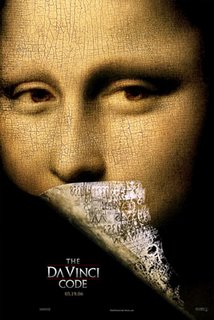 It was called “The Last Temptation of Christ”, being based on the literary success by Nikos Kazantzakis and directed by maestro Martin Scorsese. That neo-classic was also a financial failure and a media cause celebre for the fury it ignited amongst conservative Christians, who vehemently protested the films release. (Of course, without having ever read the novel or bothering to watch the film, but such is often the case with religious fanaticism.)
It was called “The Last Temptation of Christ”, being based on the literary success by Nikos Kazantzakis and directed by maestro Martin Scorsese. That neo-classic was also a financial failure and a media cause celebre for the fury it ignited amongst conservative Christians, who vehemently protested the films release. (Of course, without having ever read the novel or bothering to watch the film, but such is often the case with religious fanaticism.) By now, most of you know that “The Da Vinci Code” is based on the potboiler goldmine penned or plundered (Depends who you would believe.) by Dan Brown. In the name of full disclosure, we will cop to never having gotten past page two of the aforementioned page turner. We barely have the time to keep up with Jackie Collins or Mary Higgins Clark – so anything less worthy on the literary rating scale, we usually opt to pass on.
By now, most of you know that “The Da Vinci Code” is based on the potboiler goldmine penned or plundered (Depends who you would believe.) by Dan Brown. In the name of full disclosure, we will cop to never having gotten past page two of the aforementioned page turner. We barely have the time to keep up with Jackie Collins or Mary Higgins Clark – so anything less worthy on the literary rating scale, we usually opt to pass on.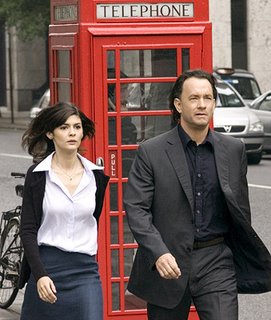 The film version of “The Da Vinci Code” is directed with a criminally sedate eye by Oscar winner Ron Howard, was adapted by his partner in crime Akiva Goldsman and features a frowsingly frumpy turn by the pudgemeister non pareil – two time Oscar winner Tom Hanks as the “intellectual” action hero, Robert Langdon.
The film version of “The Da Vinci Code” is directed with a criminally sedate eye by Oscar winner Ron Howard, was adapted by his partner in crime Akiva Goldsman and features a frowsingly frumpy turn by the pudgemeister non pareil – two time Oscar winner Tom Hanks as the “intellectual” action hero, Robert Langdon. The plot is relatively simple and completely simple minded – a crazed Albino monk murders an elderly erudite gentlemen in the glorious salons of our beloved Louvre Museum in Paris. A cryptically scrawled expiration notice alerts the Parisian constabulary to involve our hero, Robert in the fray. A policewoman, from the Paris “Code” Police . . . ahem . . . soon reveals her own special connection to the deceased and before you can say “Mission: Inviolable” – the chase is on.
The plot is relatively simple and completely simple minded – a crazed Albino monk murders an elderly erudite gentlemen in the glorious salons of our beloved Louvre Museum in Paris. A cryptically scrawled expiration notice alerts the Parisian constabulary to involve our hero, Robert in the fray. A policewoman, from the Paris “Code” Police . . . ahem . . . soon reveals her own special connection to the deceased and before you can say “Mission: Inviolable” – the chase is on.
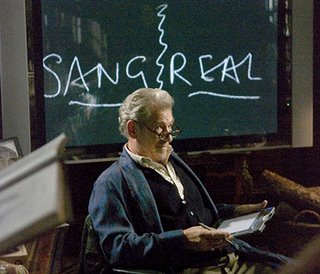 And oh, what a lengthy, chatty, non-linear, purloined and clumsy chase it is. The film version deserves credit for the top notch production values, fine use of real locations (our beloved Paris, Louvre, London, etc.) and in particular to the casting of two time Oscar nominee Dame Ian McKellen as a charming, crusty, crippled scholar who seemingly is available to answer all our questions and pose a few of his own. And speaking of cripples, did “novelist” Dan Brown concoct all of his characters as physically or emotionally “handicapped” on purpose, or is he just a glutton for hackneyed clichés? We choose the latter.
And oh, what a lengthy, chatty, non-linear, purloined and clumsy chase it is. The film version deserves credit for the top notch production values, fine use of real locations (our beloved Paris, Louvre, London, etc.) and in particular to the casting of two time Oscar nominee Dame Ian McKellen as a charming, crusty, crippled scholar who seemingly is available to answer all our questions and pose a few of his own. And speaking of cripples, did “novelist” Dan Brown concoct all of his characters as physically or emotionally “handicapped” on purpose, or is he just a glutton for hackneyed clichés? We choose the latter.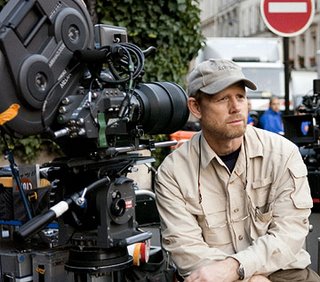 While we have absolutely no doubt to the capacity of the filmmakers to craft an exciting melodrama from various interwoven plotlines, we are left to ponder that perhaps the source material was too ripe for the transition. Certainly, Ron Howard has done good work in the past: his Oscar winning “A Beautiful Mind” was a wonderful example of A-list Hollywood Studio material, his multi-layered and visually ravishing “Apollo 13” reinvigorated the “real life” action adventure, and last year’s “Cinderella Man” delivered the goods despite the supporting role played by Renée Zellweger. Then again, Ron Howard is also responsible for “The Paper”, “Ransom”, “EdTV”, “How the Grinch Stole Christmas”, “The Missing” and perhaps the worst film of the past twenty five years – “Backdraft” which exemplifies many of the problems with “The Da Vinci Code”. Maudlin theatrics, muddled storytelling, preachy and visually archaic moments of self aggrandizement. And just plain bad moviemaking.
While we have absolutely no doubt to the capacity of the filmmakers to craft an exciting melodrama from various interwoven plotlines, we are left to ponder that perhaps the source material was too ripe for the transition. Certainly, Ron Howard has done good work in the past: his Oscar winning “A Beautiful Mind” was a wonderful example of A-list Hollywood Studio material, his multi-layered and visually ravishing “Apollo 13” reinvigorated the “real life” action adventure, and last year’s “Cinderella Man” delivered the goods despite the supporting role played by Renée Zellweger. Then again, Ron Howard is also responsible for “The Paper”, “Ransom”, “EdTV”, “How the Grinch Stole Christmas”, “The Missing” and perhaps the worst film of the past twenty five years – “Backdraft” which exemplifies many of the problems with “The Da Vinci Code”. Maudlin theatrics, muddled storytelling, preachy and visually archaic moments of self aggrandizement. And just plain bad moviemaking. It also doesn’t help that Tom Hanks is about fifteen years past his prime as an action adventure hero. Sporting the worst hairdon’t this side of an Elks’ Lodge convention, dragging twenty five pounds of extra lard girdled around his neckline and flashing his jowly grimace at the high dramatic points (which are too few and way too far between), he resembles a float during the Macy’s Thanksgiving Day Parade gone astray. The resemblance is intensified in one harrowing (for the audience at least) scene wherein our heroine portrayed with a suck-it-up-its-a-beeg-paycheck aloofness by the normally enchanting Audrey Tautou.
It also doesn’t help that Tom Hanks is about fifteen years past his prime as an action adventure hero. Sporting the worst hairdon’t this side of an Elks’ Lodge convention, dragging twenty five pounds of extra lard girdled around his neckline and flashing his jowly grimace at the high dramatic points (which are too few and way too far between), he resembles a float during the Macy’s Thanksgiving Day Parade gone astray. The resemblance is intensified in one harrowing (for the audience at least) scene wherein our heroine portrayed with a suck-it-up-its-a-beeg-paycheck aloofness by the normally enchanting Audrey Tautou.
 For you see in order to help our hero Langdon with his chronic claustrophobia, our heroine Sophie recounts her parents’ death via a horrific car accident that left her with a wonderful parlor trick of “hands on healing”. She grasps his blubbery cheeks, the ones on his face thankfully and begins to weave her spell. The end result is so shocking visually we screamed out loud in horror. She resembled a Thalidomide child juggling an engorged beach ball.
For you see in order to help our hero Langdon with his chronic claustrophobia, our heroine Sophie recounts her parents’ death via a horrific car accident that left her with a wonderful parlor trick of “hands on healing”. She grasps his blubbery cheeks, the ones on his face thankfully and begins to weave her spell. The end result is so shocking visually we screamed out loud in horror. She resembled a Thalidomide child juggling an engorged beach ball. Sadly, that scene was the most shocking and horrifying in the entire splash and dash murder mystery with a dab of fake religion tossed in. We were shocked to know from acquaintances (permanently dead to us now) that many of the sheep who flocked to their local B&N to purchase the original tome believe wholeheartedly in the twisting, turning and massacring of the history on display here. By playing freely with the real histories of the Knights of the Templar, the alleged history of the Priory of Sion and bastardizing the history of the Opus Dei organization, Dan Brown has done more damage than George W. Bush on an unarmed Iraqi household filled with children.
Sadly, that scene was the most shocking and horrifying in the entire splash and dash murder mystery with a dab of fake religion tossed in. We were shocked to know from acquaintances (permanently dead to us now) that many of the sheep who flocked to their local B&N to purchase the original tome believe wholeheartedly in the twisting, turning and massacring of the history on display here. By playing freely with the real histories of the Knights of the Templar, the alleged history of the Priory of Sion and bastardizing the history of the Opus Dei organization, Dan Brown has done more damage than George W. Bush on an unarmed Iraqi household filled with children. While we understand that it may be “fun” to some sick individuals to shop their brief snippets of history from cheap airport mass paperbacks, they might actually try to crack open an honest portrayal of the times in question. Shame on them.
While we understand that it may be “fun” to some sick individuals to shop their brief snippets of history from cheap airport mass paperbacks, they might actually try to crack open an honest portrayal of the times in question. Shame on them. The only line concerning historical “evidence” that rang true to us was the slapping down of the ancient myth of Mary Magdalene being a prostitute. She wasn’t. The church fathers chose to allow that vicious and slanderous route after many centuries had passed. But that lecture is for another day.
The only line concerning historical “evidence” that rang true to us was the slapping down of the ancient myth of Mary Magdalene being a prostitute. She wasn’t. The church fathers chose to allow that vicious and slanderous route after many centuries had passed. But that lecture is for another day.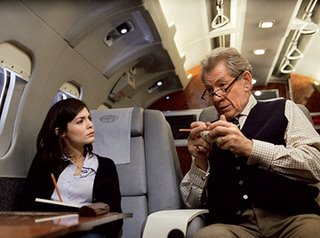 Back to the film. While pudgy runs-waddles thru the streets of the major capitals of Europe clasping Sophie’s paw as if it were part of his chicken dinner, we are forced to sit thru various lectures on fictionalized history that might have been interesting if they were true, and are only tolerable since most of them are delivered by the truly accomplished talents of Sir Ian McKellen. Sir Ian has such great fun with his role that it is far and away the only reason to sit thru two and a half hours of creaky melodrama.
Back to the film. While pudgy runs-waddles thru the streets of the major capitals of Europe clasping Sophie’s paw as if it were part of his chicken dinner, we are forced to sit thru various lectures on fictionalized history that might have been interesting if they were true, and are only tolerable since most of them are delivered by the truly accomplished talents of Sir Ian McKellen. Sir Ian has such great fun with his role that it is far and away the only reason to sit thru two and a half hours of creaky melodrama.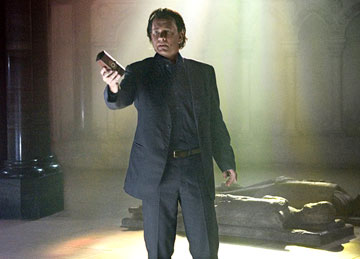 The pilfering and plundering of religious history might have made for an interesting storyline in the hands of an accomplished author. Dan Brown is not one. The film version of a pulp mystery might have made for an exciting thriller. “The Da Vinci Code” is definitely not one. If ever a script called for a pyrotechnical directorial style, this is it. Ron Howard, despite some wonderful films in his past, is simply not the visual stylist required to pull it off.
The pilfering and plundering of religious history might have made for an interesting storyline in the hands of an accomplished author. Dan Brown is not one. The film version of a pulp mystery might have made for an exciting thriller. “The Da Vinci Code” is definitely not one. If ever a script called for a pyrotechnical directorial style, this is it. Ron Howard, despite some wonderful films in his past, is simply not the visual stylist required to pull it off. Do yourselves a favor. Avoid “The Da Vinci Code”. The book and the movie. Go flagellate yourselves instead. It’ll at least get rid of some dead skin cells. Bless you all!
Do yourselves a favor. Avoid “The Da Vinci Code”. The book and the movie. Go flagellate yourselves instead. It’ll at least get rid of some dead skin cells. Bless you all!
Directed by Ron Howard
Written by Akiva Goldsman
Based on the potboiler by Dan Brown
Starring
Tom Hanks as Robert Langdon
Audrey Tautou as Sophie Neveu
Ian McKellen as Sir Leigh Teabing
Jean Reno as Captain Fache
Paul Bettany as Silas
Alfred Molina as Bishop Aringarosa
Jűrgen Prochnow as Andre Vernet
Original Music by Hans Zimmer
Cinematography by Salvatore Totino
Film Editing by Daniel P. Hanley & Mike Hill
Production Design by Allan Cameron
Art Direction by Giles Masters & Tony Reading
Set Decoration by Richard Roberts
Costume Design by Daniel Orlandi


0 Comments:
Post a Comment
<< Home